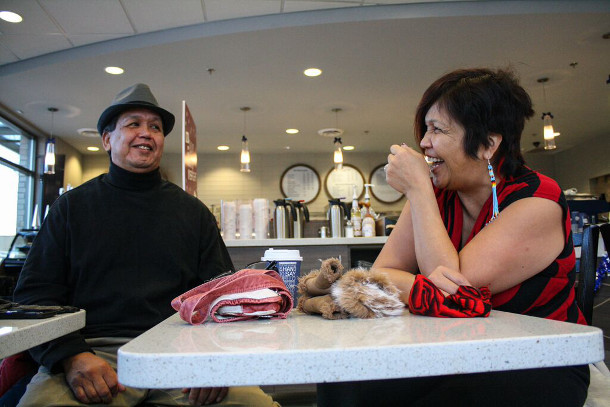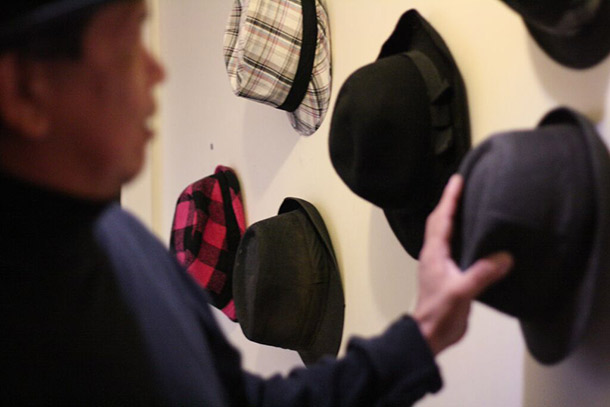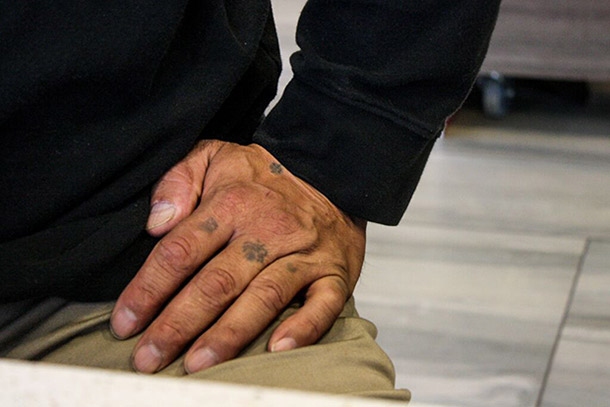I first met Dennis Bob six years ago, at a white-walled Waves coffee shop in Burnaby. He came armed with a Ziploc bag full of photos from his past. Also in the bag was a newspaper cutout image of a rabbit with a cat’s face drawn on it in pen. He laughed when he pulled it out to show me. He’d brought the image to look at when he got emotional. His girlfriend, Cynthia Keitlah, sat nearby in case he needed support.
At over six-feet-tall, he’s an imposing figure. The cross tattoo near his left eye, along with the rest of his tattoos — most of which are skulls — he said he got in prison. He thought looking tough would keep people at a distance. “But it brought in rotten people and made us all rotten,” he said.
Bob, who says he is “58 plus tax,” attended Alberni Indian Residential School. He arrived at the school just before his fifth birthday in the late 1960s — four years after Gina Laing (profiled yesterday) had finished — and left three years later.
Today he wears an artificial eardrum on his left ear where he was hit repeatedly. He still has a lot of pain and the ringing in his ear has not stopped. His abuser, dorm supervisor Arthur Henry Plint, was sentenced to 11 years in prison, in 1997, after pleading guilty to charges of indecent assault. Plint’s trial was the third residential school case to be filed by a group of Indigenous claimants and prompted an RCMP investigation of similar schools across British Columbia.
Bob shared his story at the Truth and Reconciliation Commission national event in Vancouver, British Columbia in September 2013. He wore a cedar braid headband and carried a drum on stage with him into the large auditorium before sitting at a table facing commissioner Marie Wilson. He and his table of supporters filled two large screens on either side of the stage. As he spoke he looked down, heaving big laboured breaths that lifted his chest and shoulders. He fought through a cracking voice, clearing his throat several times between reading the words he’d scrawled on a piece of lined paper.
The next year, he relayed his testimony for the Independent Assessment Process, which provides compensation for survivors who suffered physical or sexual abuse at residential schools. He forgot his photo of the rabbit with the cat face, but he did bring a class photo, of when he was five or six, from his time at residential school. In the picture, the bottom of his pant leg is darker than the rest. He wanted the government officials to see how he’d wet himself.
“I wanted them to understand why that little boy peed himself,” he said. “Because he was abused.” Bob said his hands trembled as he went in on his own. He wore the cedar bandana, made by Keitlah, with small feathers from the tips of an eagle wing for strength. Keitlah waited for him in the lobby along with his mom and his auntie.
“After I spoke about it I cried so hard I almost got rid of [the pain],” he said. “I have a little more and then I’m done, I’m hoping.”
‘The spirits were with me’
Dennis Bob says the day he shared his experience of residential school at the Truth and Reconciliation event in Vancouver remains a blur. He recounted the day to me shortly after we met, when I visited his home in Burnaby.
Miniature Chinese New Year floats hung from the ceiling in the corner of his living room. He sat in an office chair a good six feet away from the couch that his girlfriend and I sat on. A few times he would begin to answer a question, then turn to Keitlah to finish for him. “Over to you, Cyndie.”
He remembered crying a lot that day, and doesn’t remember many other people’s stories. Keitlah said that’s because he left the room several times. But he is glad he shared his story. “I think the Elders, the spirits were with me,” he said. “Helping me, making me strong. It was excellent.” Afterwards he met other people who attended Alberni Indian Residential School, including the sister of his best friend at the time. At the end of it all, he took a bath and went to bed.
I asked Bob what he does now when he has a particularly difficult day or night. He’ll watch a movie. “A funny movie probably,” he said. Keitlah challenged him, gently. “When you have a rough day, which movie would you put on when you come home?” He was quiet. And then she answered. “He watches Apocalypto. It’s really gory. Or The Deer Hunter. Natural Born Killers. He just has to get in there and get it out.” Bob nodded. “Lots of guns,” he said. He likes gangster movies — Scarface, American Me or Blood In Blood Out. He likes true stories and said he misses his guns sometimes. “Maybe that’s why,” he said.
He excused himself and went to the bathroom — something he explained earlier that he does when he’s uncomfortable.
“He becomes a part of the movie,” Keitlah said. “I think he plays a hero villain guy. He watches it and becomes a part of the movie.” She’ll ask him questions throughout — is prison really like that? Do the guards really treat the inmates that horribly? Is that what a drive-by shooting looks like? He answers her questions patiently, retelling his own experiences. He misses the excitement of those times, but chooses to instead live vicariously through the fictional characters.
Practicing resurgence
Bob became disconnected from his culture during and after residential school. Moving in and out of prison since he was a teenager, coupled with disagreements over land settlements, estranged him from his community. I asked him to tell me more about the cedar braid he wore around his head when he testified at the Truth and Reconciliation Commission. He’s not sure about the traditional significance of cedar, but said, “Cyndie made it for me. I wear it because it represented the Native people. It made me feel good. It made me feel proud.”

Jeff Corntassel, a Cherokee scholar and professor of Indigenous governance, writes about the importance of “practicing everyday acts of resurgence.” In order to challenge systemic colonialism, he said, one must reclaim traditional practices. He maintains that “these daily acts of renewal, whether through prayer, speaking [traditional] language, honouring... ancestors, etc. are foundations of resurgence.”
Keitlah teaches Bob the ways of her people — the Ahousaht First Nation. She bought him a traditional drum and shows him how to burn sage. She also attended residential school. The two met at a treatment centre on the Tsow-Tun Le Lum reserve outside Nanaimo five years ago. “My heart was breaking into so many pieces,” she said. “Dennis has helped me find them to get them back together.”
Both were there for the eight-week trauma treatment program for survivors. The program required sobriety. It was the first time Bob had been sober in a long time. Keitlah remembers he’d walk up to tables snarling, causing people to move out of their seat for him. “People were scared of him.” The turning moment arrived when he went on stage to participate in a psychodrama. The idea was to recreate an interaction between him and his abuser. But the drama only got as far as having an elderly man sit in a chair in front of him.
“I said you’d better move him. He’s way too close. I’m gonna punch him,” Bob recalled. They tried to explain that this was part of the therapy. But he wasn’t persuaded. “I don’t care, I’m gonna punch him.” So the facilitators had another staff stand in, pretending to be Bob, while they continued to act out the hypothetical scene. As the scene progressed, “I started to cry and cry and cry,” he said. “I’d never cried before. I wasn’t allowed to cry in residential school, in jail. You didn’t let them see your tears.” He said this was the first time he faced what had happened to him.
He left the centre smiling that night. “Now I cry. And I’m happy. They put a smile on my face when I left.” Today, it’s difficult to imagine him not smiling. He is quick to make jokes, calling Keitlah “the warden,” and wearing a T-shirt that says “Sofa king cool.” Keitlah said he is the one in his family to bring up residential school. “When Dennis is around, he is the light for them. He’s the light for me too.”

Dennis Bob’s experience at residential school continues to affect his life. He doesn’t like it when men get too close to him — particularly elderly men. If he finds himself on a crowded bus and a man steps near him, he moves away and sometimes gets off to wait for the next bus.
Bob was only five when he was sexually abused. “A baby,” said Keitlah. He has difficulty recalling what happened to him because many of his memories are fuzzy. Bob has become more accustomed to speaking about his experiences, but certain memories are difficult — painful and also tough to recall because he repressed them for so long. “Something about lemon jam…. ” Bob sucked in and held his breath, releasing again stiltedly. “I can’t remember. Something disgusting.” He recalled his stomach hurting. And he’d been given an apple afterwards. Another kid asked for the core when he was finished. “Everybody was hungry there.” He remembers “something about the basement” and “something about the house behind the school.”
He left then and went to the bathroom again.
Corntassel writes that daily acts of resurgence are not glamorous. Sometimes they are messy. Sometimes they are angry. Often they are simple. Simply remembering what happened, or in Dennis’s case trying to, contributes to healing. Corntassel differentiates between reconciliation and resurgence, saying that “processes of reconciliation are merely reinscribing the status quo” while resurgence “takes the emphasis away from state frameworks of ‘forgive and forget’ back to relocalized, community-centred actions.” Truth telling is central to this.
When Bob returned after several minutes, he was smiling. “The one thing I remember from [residential school] was my marbles. Because I lost them,” he joked. He’d play marbles with the other kids in the courtyard. He’d draw a circle in the dirt, put a big marble in the middle and try to push it out of the circle by flicking the smaller marble towards it. Still today, whenever he sees marbles he has the urge to pocket them.
Keitlah rolled her eyes and sighed. “You should have seen him when we first met. He’d bring home these pockets full of rocks and marbles. They’d be all piled up on the shelf.” She thought for a moment. “What is with that? Why do you do that?”
He laughed and shrugged the question off, mumbling something about collecting them for her plants. Then he was quiet for a few seconds. “I guess it’s because I never had nothing. So I want things.” I thought back to the wall of hats near the entrance — a cacophony of colourful, patterned fedoras hanging in neat lines.
Recently, I reconnected with Bob on the phone. He said he is dealing with living with trauma by engaging in counselling and connecting more with the cultural traditions of his Pauquachin First Nation through carving, potlatch ceremonies and smudging.
When he shares his story publicly, Keitlah still steps in to help when he needs that extra support. But Bob says he is finding his voice.
He no longer lives in Burnaby, he told me. He has moved to the town where he was forced to attend residential school, Port Alberni. “The belly of the beast,” he called it. He finds healing, he said, in looking straight at the part of his life that scares him.
Meet residential school survivor Gina Laing in the first part of this series here. ![]()
Read more: Indigenous, Rights + Justice
















Tyee Commenting Guidelines
Comments that violate guidelines risk being deleted, and violations may result in a temporary or permanent user ban. Maintain the spirit of good conversation to stay in the discussion.
*Please note The Tyee is not a forum for spreading misinformation about COVID-19, denying its existence or minimizing its risk to public health.
Do:
Do not: